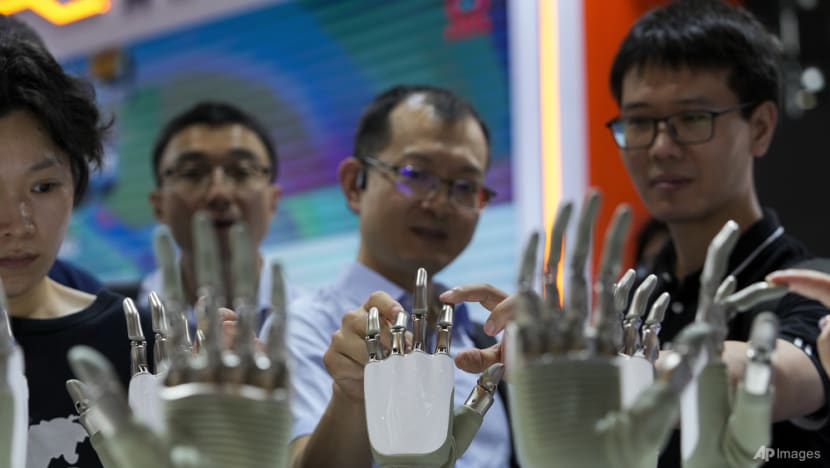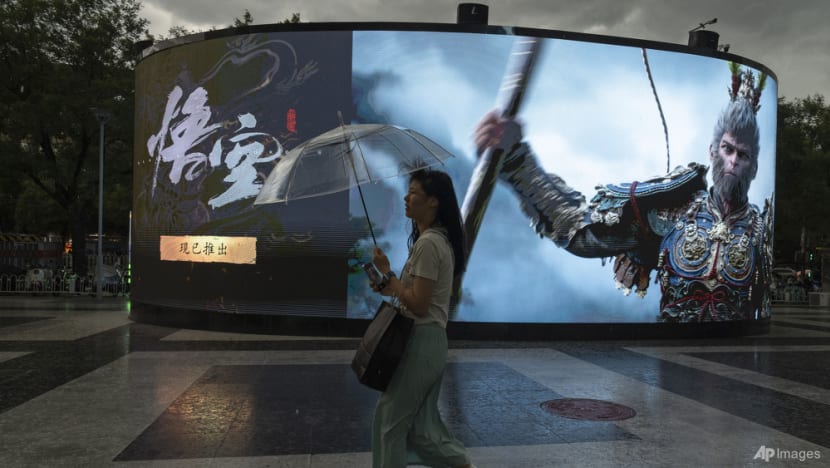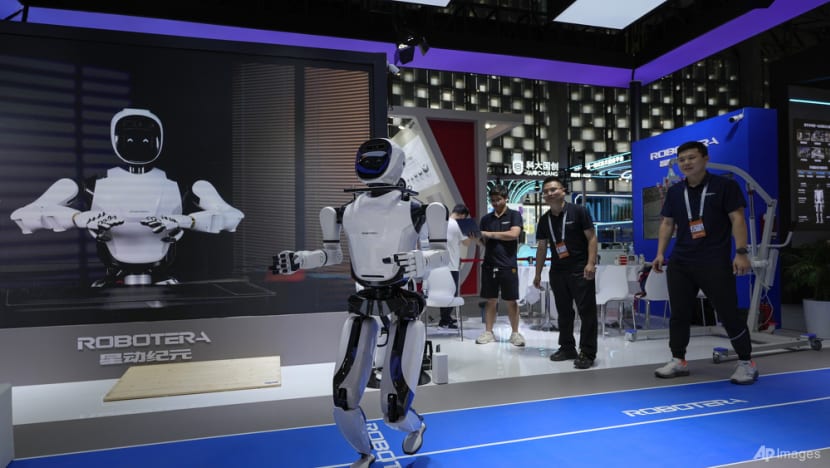How far has China gone into making its AI ambitions a reality?
Industry insiders told CNA that China has the pre-conditions to develop and excel in more AI applications.

Visitors touch the humanoid robot hands on display at an AI exhibition booth during the 2024 The World Artificial Intelligence Conference (WAIC) & High-Level Meeting on Global AI Governance with the themed "Governing AI for Good and for All" at the Shanghai Expo Center Multifunction Hall in Shanghai China, Thursday, July 4, 2024. (AP Photo/Andy Wong)

This audio is generated by an AI tool.
SHANGHAI: Imagine a world where anyone can create a short drama without leaving their desks.
Chinese online game publisher Kunlun Tech is already testing an artificial intelligence platform named SkyReels that could make that a reality.
The AI tool is able to generate characters, plots, dialogue and storyline to create a short video with just prompts.
“To film a short drama manually costs on average US$71,000 to US$284,000. Using our SkyReels AI short drama platform, we could lower the cost to just a few hundred dollars,” said Fang Han, chairman and CEO of Kunlun Tech.
“This is very meaningful because it allows more people to join the ranks of video creators.”
USING AI GENERATIVE CONTENT
In 2017, China released a government plan to establish itself as a global leader in AI by 2030.
Its gaming sector has already been using AI generative content for many years to make better games.
“This includes character development, rendering backdrops, and using the AI generative content model to quickly create better content as well as characters,” said Chen Liang, general manager of Tencent Cloud’s internet industry department.
“We now see more open world games, with fresh characters and new storylines at every level.”
China’s recent video gaming hit Black Myth: Wukong, for instance, uses AI and machine learning to enhance the behaviours of non-playable characters.

CREATING AI PRODUCTS
Content is just one area of AI that China has been making progress in.
The country is now also leading in autonomous vehicles and facial recognition.
Industry insiders told CNA that China has the pre-conditions to develop and excel in more AI applications.
“China has the world’s largest single market of internet users,” said Steve Shen, managing partner at tech recruitment firm Empower.
“We possess enough conditions and space for new and innovative AI products to emerge. What’s more, China is the world’s largest manufacturing base. We can use AI to power robots to help us raise productivity.”
China is good at turning technologies into products, said Kunlun Tech’s Fang. “So in this aspect, the Chinese will make further progress.”

TAPPING THE AI TALENT POOL
He added that China has the world’s largest pool of AI engineers.
Every year, there are about 3.7 million STEM (science, tech, engineering and mathematics) graduates in China, said Fang. The United States, in comparison, produces 800,000.
“Annually, China publishes the highest number of AI academic papers in the world, more than the US,” he added. “However, in terms of highly-cited papers, the US takes the top spot, and China is second.”
But at the top end of the AI talent pool, China is losing to the US.
A 2022 survey found that among the top 2 per cent of AI talent worldwide, only 12 per cent work in China, whereas 57 per cent work in the US.
It is still an improvement from 2019, when China did not feature among the leading countries.
While China trails the US in high-end AI research, it is making great strides in applying AI in real-world scenarios.
China has various advantages including its huge consumer market and vast data resources, “which can be fed into the algorithm which makes it more precise and accurate”, said Patrick Liu, a researcher at Roland Berger Strategy Consultants.
“The more data you have, the more precise and accurate your product would be, which means it would achieve better market performance,” he told CNA's East Asia Tonight.
“(Then,) you would attract more consumers to use your product, which in turn generates more data to feed into your algorithm, (making) it a positive cycle.”
PREPARING FOR AN AI FUTURE
Liu said with AI reducing labour costs, manpower can instead be “used to a more creative and more valuable approach, rather than having (employees) do repetitive work”.
But other observers cautioned that AI adoption could disrupt the labour market and worsen unemployment.
“Those jobs that can be completed on the computer would be impacted the most,” said Fang.
“Offline jobs, such as delivery services and manufacturing, would be impacted less by AI. Still, even as some jobs disappear, new jobs will emerge.”
On what jobseekers should do to prepare for a future powered by AI, he noted that they should start learning how to use large language models – AI algorithms that use deep learning processes and large data sets to understand and generate new content.
This is a skill known as prompt engineering, "which would be like what typing skills used to be", he said.
“The earlier you can master prompt engineering, the more you'll be able to have an edge in the age of AI.”


















